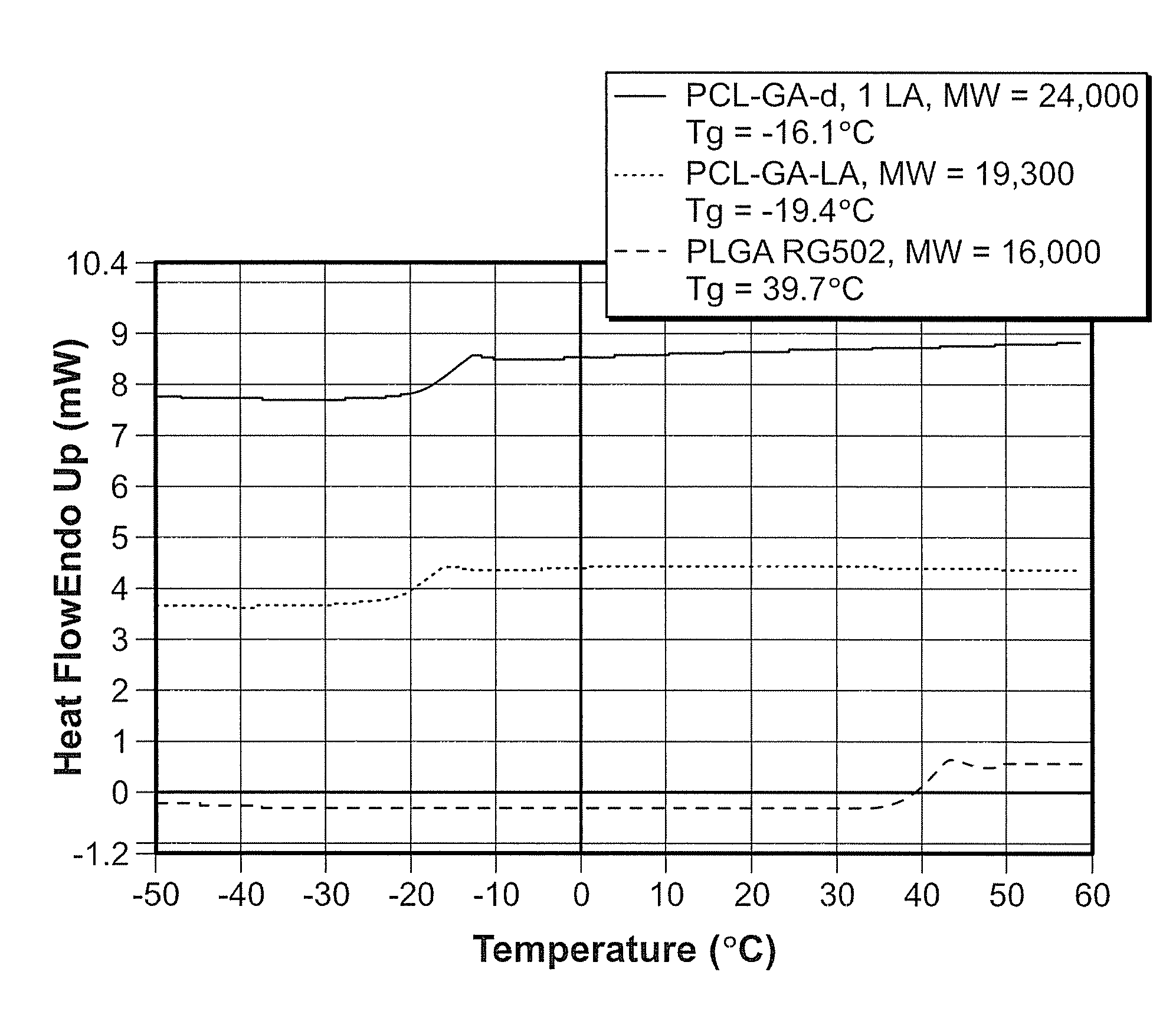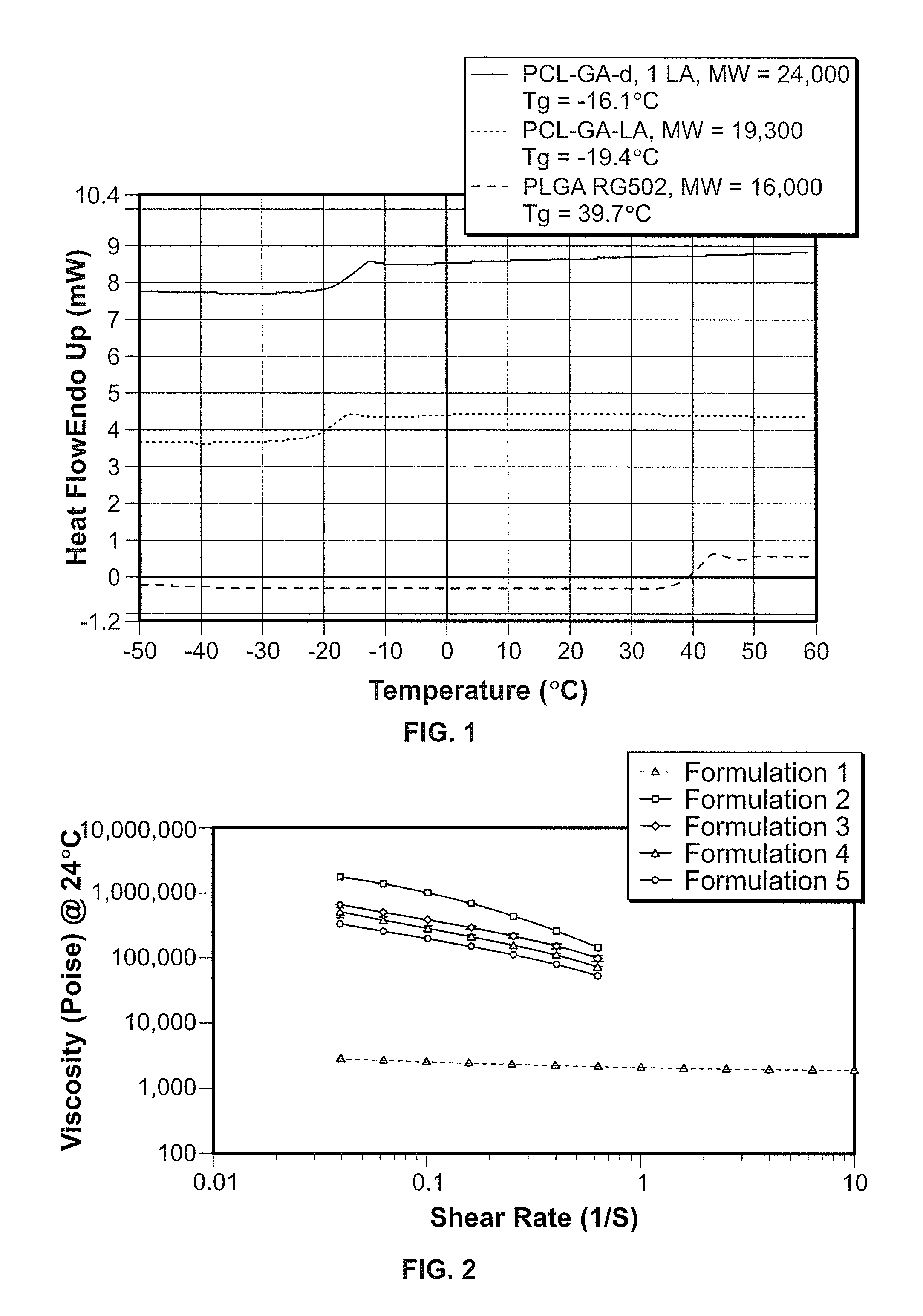Implantable elastomeric caprolactone depot compositions and uses thereof
a technology of elastomeric caprolactone and depot composition, which is applied in the direction of depsipeptides, antibacterial agents, peptide/protein ingredients, etc., can solve the problems of adverse tissue reaction or other complications associated with the occurrence of foreign matter in bodily tissue, and the material does not always meet the demand for biodegradable implants, etc., to achieve the effect of improving patient compliance and reducing the frequency of administration
- Summary
- Abstract
- Description
- Claims
- Application Information
AI Technical Summary
Benefits of technology
Problems solved by technology
Method used
Image
Examples
example 1
Synthesis of Poly(ε-caprolactone-co-glycolide-co-L,lactide)
(PCL-GA-L, LA) 40:55:5
Synthesis of Low Molecular Weight PCL-GA-L, LA
[0173] In the glove box, 168 μL (55 μmol) of a 0.33 M stannous octoate solution in toluene (Ethicon Inc., Cornelia, Ga., USA), 5.31 grams (50 mmol) of diethylene glycol (Fluka Chemical Co., Milwaukee, Wis., USA), 156.7 grams (1.35 mol) of glycolide (Noramco, Inc., Athens, Ga., USA), 117.0 grams (1.025 mol) of ε-caprolactone (Union Carbide Corp., Danbury, Conn., USA), and 18.0 grams (0.125 mol) L-lactide (Purac America, Lincolnshire, Ill., USA) were transferred into a flame dried, 500 mL round bottom flask equipped with a stainless steel mechanical stirrer and a nitrogen gas blanket. The reaction flask was placed in a room temperature oil bath, heated to 190° C. and then held at 190° C. for 16 hours. The reaction was allowed to cool to 80° C., then poured out of the flask into a clean dry polypropylene jar. The terpolymer was then vacuum dried overnight a...
example 2a
Synthesis of Poly (ε-caprolactone-co-glycolide-co-D,L,lactide)
(PCL-GA-DL, LA) 40:55:5
[0176] In the glove box, 168 μL (55 μmol) of a 0.33 M stannous octoate solution in toluene (Ethicon Inc., Cornelia, Ga., USA), 2.65 grams (25 mmol) of diethylene glycol (Fluka Chemical Co., Wis., USA), 156.7 grams (1.35 mol) of glycolide (Noramco, Inc., Athens, Ga., USA), 117.0 grams (1.025 mol) of ε-caprolactone (Union Carbide Corp., Danbury, Conn., USA), and 18.0 grams (0.125 mol) D,L-lactide (Purac America, Lincolnshire, Ill., USA) were transferred into a flame dried, 500 mL round bottom flask equipped with a stainless steel mechanical stirrer and a nitrogen gas blanket. The reaction flask was placed in a room temperature oil bath, heated to 190° C. and then held at 190° C. for 16 hours. The reaction was allowed to cool to room temperature overnight. The terpolymer was isolated from the reaction flask by freezing in liquid nitrogen and breaking the glass. Any remaining glass fragments were remo...
example 2b
Synthesis of Poly (ε-caprolactone-co-glycolide-co-L,lactide)
(PCL-GA-L, LA) 50:40:10
[0177] In the glove box, 154 82 L (51 μmol) of a 0.33 M stannous octoate solution in toluene (Ethicon Inc., Cornelia, Ga., USA), 2.18 grams (21 mmol) of diethylene glycol (Fluka Chemical Co., Wis., USA), 106.8 grams (0.92 mol) of glycolide (Noramco, Inc., Athens, Ga., USA), 131.3 grams (1.15 mol) of ε-caprolactone (Union Carbide Corp., Danbury, Conn., USA), and 33.2 grams (0.23 mol) L-lactide (Purac America, Lincolnshire, Ill., USA) were transferred into a flame dried, 500 mL round bottom flask equipped with a stainless steel mechanical stirrer and a nitrogen gas blanket. The reaction flask was placed in a room temperature oil bath, heated to 190° C. and then held at 190° C. for 16 hours. The reaction was allowed to cool to room temperature overnight. The terpolymer was isolated from the reaction flask by freezing in liquid nitrogen and breaking the glass. Any remaining glass fragments were removed ...
PUM
| Property | Measurement | Unit |
|---|---|---|
| particle size | aaaaa | aaaaa |
| particle size | aaaaa | aaaaa |
| time | aaaaa | aaaaa |
Abstract
Description
Claims
Application Information
 Login to View More
Login to View More - R&D
- Intellectual Property
- Life Sciences
- Materials
- Tech Scout
- Unparalleled Data Quality
- Higher Quality Content
- 60% Fewer Hallucinations
Browse by: Latest US Patents, China's latest patents, Technical Efficacy Thesaurus, Application Domain, Technology Topic, Popular Technical Reports.
© 2025 PatSnap. All rights reserved.Legal|Privacy policy|Modern Slavery Act Transparency Statement|Sitemap|About US| Contact US: help@patsnap.com



